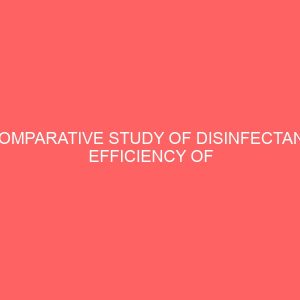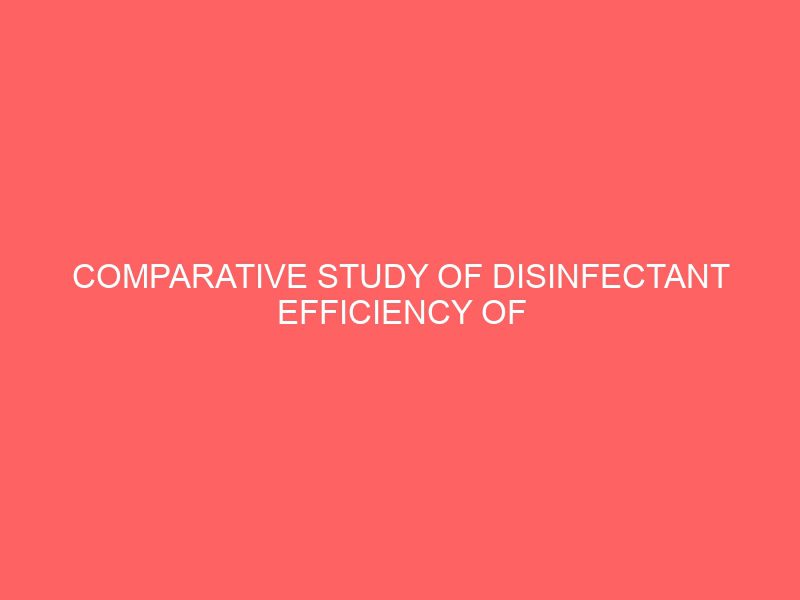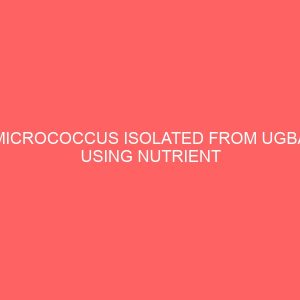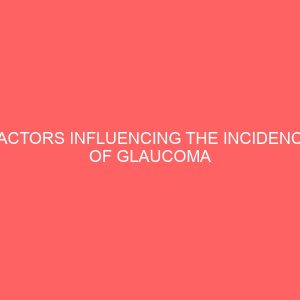Description
TABLE OF CONTENTS
Title Page i
Certification ii
Dedication iii
Acknowledgements iv
Table of Contents v
List of Tables vi
List of Figures vii
List of Plates viii
Abstract ix
CHAPTER ONE
1.0 Introduction 1
1.1 Aims and Objectives 2
CHAPTER TWO
2.0 Literature Review 5
2.1 History of Disinfectants 6
2.2 About Disinfectants 7
2.3 Sources of Contamination of Surfaces 8
2.4 Types of Disinfectants 9
2.5 Properties of A Disinfectant 18
2.6 General Features of Disinfectant 19
2.7 General Features of the Test Organisms 24
2.9 Mechanism of Actions of Disinfectants against Bacteria 26
2.10 Resistant Action of Bacteria 27
2.11 Advantages and Disadvantages of Disinfectants 29
2.12 General Guidelines in the Use of Disinfectants 33
CHAPTER THREE
3.0 Material and Method 36
3.1 Isolation of Bacteria 36
3.2 Identification of Isolates 37
3.3 Preparation of Disinfectants 40
3.4 Antimicrobial Susceptibility Testing Using Kirby Bauer
Diffusion Assay Well Method 41
CHAPTER FOUR
4.0 RESULTS 43
CHAPTER FIVE
5.0 Discussion 57
5.1 Recommendations 60
5.2 Conclusion 51
References 62
Appendix 1 69
Appendix II 71
Appendix III 74
ABSTRACT
Ethanol, Bleach and Phenolics are three kinds of disinfectants which have been widely used in common laboratories. In this study, a compared experiment on these three disinfectants efficiency was conducted against Staphylococcus aureus and Pseudomonas aeruginosa using agar hole diffusion method. Different concentrations of bleach 1, 2, 3, 4 and 5 were used on both organisms. Also 50, 60, 70, 85 and 95 of ethanol as well as 5, 10, 20, 25, and 30 Phenolics were used. Diffrences in concentrations tested was because, the original concentrations of the disinfectants differs. After 24 hours of incubation at 370C, the results showed that all the disinfectants inhibited the growth of the test organism in their concentrated forms. The diameter of zone of inhibitions were measured around each well by using a ruler in millimeters, using different concentrations, their efficacies varied. The results showed that 30 Phenolics had the best efficiency against both test organisms and 5 bleach had a better effect on Staphylococcus aureus than Pseudomonas aeruginosa, while ethanol showed least sensitivity. 70 concentration gave the highest effect on Staphylococcus aureus as compared with Pseudomonas aeruginosa.
CHAPTER ONE
1.0 INTRODUCTION
Microorganisms are minute living things that individually are too small to be seen with the unaided eyes Tortora et al, 2007. Though only a minority of microorganisms are pathogenic disease producing, practical knowledge of microbes is necessary for medicine and related health sciences. For example hospital workers must be able to protect patients from common microbes that are normally harmless but pose a threat to the sick and injured. Thousands of people died in devastating epidemics; the cause of which was not understood. Entire families died because vaccination and antibiotics were not available to fight infection Johnson and Case, 1995. This leads to scientific control of microbial growth. This began only about 100 years ago. It was Pasteurs work on microorganism that led scientists to believe that microbes were a possible cause of diseases and need to be eliminated or destroyed. Some examples off these microbes are; Bacteria, fungi, viruses and protozoa etc Tortora et al, 2007.
In the mid 1800s, the Hungarian physician Ignaz Semmeliveis and English physician Joseph Lister used these thoughts to develop some of the first microbial control practice for medical procedures. These practices include hand washing with microbes killing chloride of lime and use of techniques of aseptic surgery to prevent microbial contamination of surgical wounds Hamamah, 2004. Over the last century, scientists have continued to develop a variety of physical methods and chemical agents to control microbial growth. Control directed at destroying harmful microorganisms is called disinfection. It usually refers to the destruction of vegetative nonendospore forming pathogens example bacteria by using a disinfectant to treat an inert surface or substances Bhatia and Icchpujani, 2008.








Reviews
There are no reviews yet.